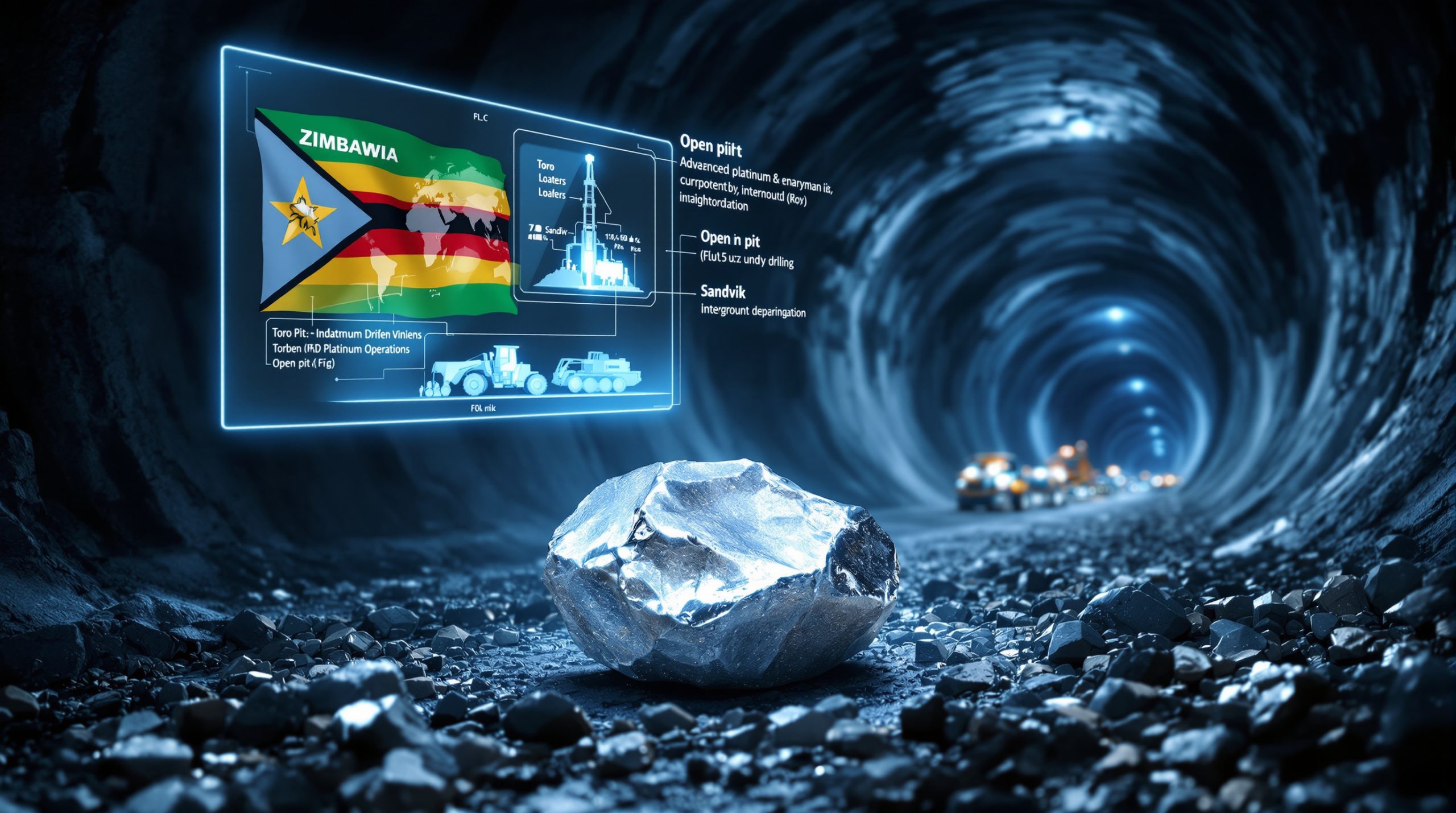Sandvik's Major Equipment Order from Zimplats: Transforming Zimbabwe's Underground Mining
What is the significance of Sandvik's recent equipment order from Zimplats?
The recent Skr280m ($29.96m) equipment order from Zimplats represents a transformative investment in Zimbabwe's mining sector, highlighting the country's commitment to modernizing its platinum production capabilities. This substantial contract, recorded in Q3 2025, signifies Zimplats' strategic focus on expanding underground operations at the Ngezi mines complex, one of Africa's richest platinum reserves.
The magnitude of this investment underscores the growing importance of advanced underground mining marvels in maximizing resource extraction while promoting operational efficiency. For Sandvik, this order reinforces their position as a leading provider of specialized mining equipment to major platinum producers across the African continent.
Industry experts note that investments of this caliber are relatively rare in Zimbabwe's mining sector, making this order particularly noteworthy for both the national economy and the regional mining industry.
What equipment is included in the Zimplats order?
Comprehensive Fleet Composition
The comprehensive equipment package ordered by Zimplats includes a diverse fleet of 28 specialized machines specifically designed for underground mining operations:
- 12 Toro LH209L loaders for efficient material handling
- 6 Sandvik DD211L development jumbos for precision drilling
- 5 Sandvik DS211L-V bolters for ground support installation
- 3 Toro TH545i trucks for heavy-duty material transportation
- 2 Sandvik TH430L trucks for versatile haulage applications
Technical Capabilities
Each equipment type brings specialized capabilities to Zimplats' operations:
- The Toro LH209L loaders feature advanced hydraulics and ergonomic operator cabins for efficient material movement in confined underground spaces
- Sandvik DD211L development jumbos deliver precise drilling accuracy with computerized controls for tunnel development
- DS211L-V bolters incorporate safety-enhancing features for securing underground excavations
- The truck fleet combines both medium and heavy-duty hauling capabilities to optimize the material transport system
This carefully selected equipment mix indicates a comprehensive approach to underground mining modernization, covering every aspect from excavation to material transport.
How will this equipment transform Zimplats' operations?
Operational Transition Strategy
Zimplats is implementing a strategic shift from traditional open-pit mining to more sophisticated underground operations at the Ngezi complex. This transition represents a fundamental change in mining methodology, allowing access to deeper platinum reserves while minimizing surface disruption.
Mining engineers familiar with similar transitions note that underground operations typically allow for more selective ore extraction, potentially improving mineral recovery rates while reducing waste material handling. The specialized equipment in this order is specifically designed to facilitate this operational evolution.
Timeline and Implementation Plan
The equipment delivery is scheduled between Q3 2025 and Q2 2026, indicating a carefully phased implementation approach. This graduated timeline allows Zimplats to:
- Develop necessary underground infrastructure ahead of equipment arrival
- Train personnel on new technologies and operational procedures
- Gradually transition production methods without disrupting ongoing operations
- Systematically decommission open-pit equipment as underground capacity increases
This measured implementation strategy minimizes operational disruptions while maximizing the learning curve advantages for the workforce.
Comprehensive Support Package
Beyond the equipment itself, the agreement includes specialized parts and services kits designed to support long-term equipment performance. This integrated support approach encompasses:
- Preventative maintenance programs tailored to underground operating conditions
- Specialized training for maintenance personnel and operators
- Parts inventory management systems to minimize downtime
- Technical support and troubleshooting resources
Mining technology specialists emphasize that this comprehensive support approach is crucial for maximizing equipment lifespan and operational availability in the challenging underground environment.
Why is the Ngezi mines complex strategically important?
Geographic and Geological Significance
The Ngezi complex occupies a prime position within the Hartley Geological Complex on Zimbabwe's Great Dyke, a unique linear geological formation extending approximately 550km across the country. This distinctive formation houses some of the world's richest platinum group metal deposits, with grades and mineralization characteristics that make it globally significant.
Geological surveys indicate that the Great Dyke contains approximately 85% of Zimbabwe's total platinum group metal resources, making the Ngezi complex a cornerstone of the country's mineral wealth. The complex's strategic location provides access to multiple platinum-bearing reefs within a relatively compact geographical area.
Economic Impact for Zimbabwe
As Zimbabwe's platinum sector continues to develop, the Ngezi complex serves as an economic cornerstone with far-reaching implications:
- Direct employment for thousands of skilled and semi-skilled workers
- Development of specialized technical expertise within the local workforce
- Significant foreign exchange generation through platinum exports
- Tax revenue contributions to national and regional governments
- Multiplier effects through local supplier development and community investment
Economic analysts estimate that platinum mining operations like Ngezi contribute approximately 15-20% of Zimbabwe's total export earnings, underscoring their critical importance to the national economy.
How does this order reflect industry trends in mining equipment?
Modernization of African Mining Operations
This significant investment reflects a broader trend of technological advancement across African mining operations. Leading mining companies are increasingly adopting sophisticated equipment solutions to:
- Improve operational efficiency and reduce costs per ton mined
- Enhance worker safety through automation and ergonomic design
- Extend mine life by accessing previously uneconomic reserves
- Reduce environmental impacts through more precise extraction methods
Industry data indicates that mining industry innovation investments in Africa have grown by approximately 12-15% annually over the past five years, with underground mining technology adoption accelerating particularly rapidly.
Focus on Equipment Reliability and Performance
The inclusion of comprehensive parts and service kits highlights the growing emphasis on equipment reliability in modern mining operations. This focus on performance optimization is driven by several factors:
- Rising operational costs making downtime increasingly expensive
- Complex underground environments that accelerate equipment wear
- Remote operating locations that complicate maintenance logistics
- Skilled labor shortages necessitating more reliable machinery
Mining equipment specialists note that unplanned downtime in underground operations typically costs between $10,000-$50,000 per hour, making reliability investments highly cost-effective.
Sustainability Considerations
Modern mining equipment typically incorporates numerous features that enhance operational sustainability:
- Improved fuel efficiency reducing carbon emissions and operating costs
- Enhanced filtration systems minimizing particulate pollution
- Advanced hydraulics with reduced leakage potential
- Electric or hybrid drive options for some equipment types
- Precision controls that minimize over-excavation and waste
These sustainability enhancements align with global mining industry trends toward reduced environmental footprints and improved resource utilization efficiency.
What does this partnership mean for Sandvik?
Strategic Market Position
This order strengthens Sandvik's position as a leading provider of underground mining equipment in Africa's platinum sector. Industry analysis indicates that Sandvik has been strategically expanding its presence in the African mining equipment market, with particular focus on specialized underground applications.
The Zimplats order demonstrates Sandvik's ability to secure major contracts with prominent mining operators, potentially enhancing their competitive position for future equipment tenders across the continent. Mining equipment market researchers note that successful reference installations often lead to follow-on orders both from the original customer and from competitors in the same region.
Long-term Customer Relationship
The comprehensive nature of the order, including both equipment and ongoing support services, indicates a long-term partnership between Sandvik and Zimplats. This relationship-based approach offers several strategic advantages:
- Recurring revenue streams through parts and service provision
- Opportunities to introduce new technologies as operations evolve
- Valuable field performance data to inform product development
- Enhanced brand reputation through association with premium mining operations
Mining industry consultants emphasize that equipment suppliers increasingly focus on lifetime customer value rather than one-time sales, making such partnerships strategically valuable.
Technology Implementation Showcase
Successful implementation of this equipment fleet will serve as a showcase for Sandvik's technology and capabilities in supporting the transition from open-pit to underground mining operations. This high-profile installation provides:
- A demonstration site for potential customers from across Africa
- Real-world validation of equipment performance in challenging conditions
- Opportunities to develop and test new operational methodologies
- Training ground for technical specialists serving the broader region
Such showcase implementations typically generate significant marketing value beyond the direct contract revenue, potentially influencing equipment selection decisions across multiple mining operations.
How does this equipment order compare to industry standards?
Scale of Investment
At approximately Skr280m ($29.96m), this represents a substantial equipment investment for a single mining operation. Mining financial analysts note that equipment investments of this magnitude typically indicate:
- Strong confidence in long-term resource potential
- Commitment to at least 10-15 years of continued operations
- Favorable economic projections supporting capital expenditure
- Strategic prioritization of technological advancement
When compared to similar underground mining transitions, this investment falls within the upper quartile of initial equipment packages, reflecting both the scale of Zimplats' operations and their commitment to comprehensive modernization.
Equipment Selection Strategy
The specific models chosen indicate a carefully considered equipment selection strategy. Mining equipment consultants highlight several strategic elements in the fleet composition:
- Standardization within equipment categories to simplify maintenance and training
- Size-appropriate machinery selection for the underground environment
- Balanced capacity across the production chain from drilling to haulage
- Technologies matched to the specific geological and operational conditions
This tailored approach contrasts with more generic equipment packages, suggesting substantial pre-investment analysis of operational requirements and constraints.
Comprehensive Fleet Approach
Rather than piecemeal equipment acquisition, Zimplats has opted for a comprehensive fleet approach. This integrated strategy offers several operational advantages:
- Ensured compatibility between different machine types in the production chain
- Standardized operator interfaces and control systems
- Simplified maintenance through common component use where possible
- Coordinated equipment commissioning and deployment
Mining operations researchers note that such comprehensive fleet approaches typically deliver 15-20% higher productivity than incrementally assembled equipment collections due to better system integration and workflow optimization.
What challenges might arise during implementation?
Training Requirements
Introducing 28 new pieces of specialized equipment will require comprehensive operator and maintenance training programs. Mining education specialists highlight several training challenges:
- Need for both theoretical and hands-on training components
- Potential language and technical literacy barriers
- Requirements for specialized maintenance diagnostics skills
- Training capacity limitations during normal production operations
Successful implementations typically allocate 80-120 hours of training per operator and 200-300 hours per maintenance technician to ensure proficiency with new equipment.
Underground Infrastructure Adaptation
Transitioning from open-pit to underground mining necessitates significant infrastructure development. Mining engineers identify several critical infrastructure requirements:
- Development of suitable access declines or shafts
- Installation of appropriate ventilation systems
- Construction of underground maintenance facilities
- Establishment of effective water management systems
- Development of appropriate ore handling and transport networks
These infrastructure elements must be carefully coordinated with equipment delivery to ensure operational readiness when the new fleet arrives.
Operational Integration
Integrating new equipment into existing operations without disrupting production requires careful planning. Change management specialists in the mining sector note several common integration challenges:
- Workforce adaptation to new operational procedures
- Temporary productivity dips during transition periods
- Parallel operation of old and new equipment systems
- Management of organizational resistance to change
- Alignment of production targets with implementation realities
Successful implementations typically involve detailed modern mining planning with contingency provisions to address inevitable implementation surprises.
FAQs About the Sandvik-Zimplats Equipment Deal
What is Zimplats' position in Zimbabwe's mining sector?
Zimplats stands as Zimbabwe's largest platinum group metals producer, operating the significant Ngezi mines complex. The company produces approximately 270,000 ounces of platinum annually, making it one of the largest platinum operations in Africa. Beyond its direct production, Zimplats serves as a technology and operational leader in Zimbabwe's mining sector, often establishing standards that influence practices across the industry.
How will this equipment improve mining safety?
Modern mining equipment incorporates numerous safety enhancements that significantly reduce operational risks:
- Ergonomic cabin designs that reduce operator fatigue and injury
- Enhanced visibility systems including cameras and proximity detection
- Automated functions that remove operators from hazardous areas
- Improved brake and steering systems with redundant safety features
- Fire suppression systems and emergency shutdown capabilities
Safety statistics from similar equipment implementations indicate potential accident rate reductions of 30-50% compared to older equipment generations.
What is the expected lifespan of this equipment?
Modern underground mining equipment in platinum operations typically operates for 7-10 years before major refurbishment or replacement, though actual lifespan varies based on:
- Operating hours and duty cycle intensity
- Maintenance quality and regularity
- Environmental conditions including dust, moisture and temperature
- Operator skill and adherence to proper procedures
With optimal maintenance practices, some equipment types may achieve 15,000-25,000 operating hours before requiring major overhaul, representing approximately 7-9 years of typical underground operation.
Will this equipment order impact Zimplats' production capacity?
The new equipment is expected to support Zimplats' underground expansion efforts while maintaining operational continuity. Production impacts will likely follow a typical implementation curve:
- Initial slight production decrease during implementation (3-6 months)
- Return to baseline production as operators gain proficiency (6-12 months)
- Gradual production increase as system optimization occurs (12-24 months)
- Full realization of productivity benefits (24+ months)
Mining productivity experts suggest that fully optimized underground operations with modern equipment can achieve 15-25% higher production rates than comparable operations using previous generation machinery.
Are there environmental benefits to this equipment upgrade?
Newer mining equipment offers several environmental advantages compared to older machinery:
- Reduced fuel consumption per ton of material moved (typically 10-15% improvement)
- Lower emissions of particulates and nitrogen oxides through advanced engine technology
- Decreased hydraulic oil consumption and leakage potential
- More precise excavation reducing unnecessary material disturbance
- Improved maintenance systems that reduce waste generation
These environmental improvements align with global mining industry trends toward reduced ecological impacts and improved sustainability performance.
Further Exploration and Industry Context
The Sandvik underground mining equipment order from Zimplats represents a significant development in Zimbabwe's mining sector, reflecting broader trends in mining technology adoption across Africa. The strategic transition from open-pit to underground operations at Ngezi aligns with similar transformations occurring at major platinum operations across southern Africa.
Mining technology specialists note that successful implementations of data-driven operations typically deliver multiple benefits beyond simple production metrics, including improved resource recovery, enhanced safety performance, and reduced environmental impacts. As the equipment deployment proceeds through 2026, the mining industry will be watching closely to evaluate the operational and financial outcomes of this significant investment.
For mining professionals and investors interested in platinum sector developments, this equipment implementation will provide valuable insights into the technological and operational future of Zimbabwe's mineral resources industry. Furthermore, the potential for South African beneficiation strategies could be significantly influenced by the success of this major equipment deployment, as noted by industry experts watching the project closely.
According to a recent report in Australian Mining Review, "This substantial investment in advanced underground mining technologies demonstrates a long-term commitment to sustainable resource development in the region, with potential to influence similar mining operations across southern Africa."
Ready to Get Ahead of the Next Big Mineral Discovery?
Discover why major mineral discoveries can lead to significant market returns by exploring Discovery Alert's dedicated discoveries page, powered by the proprietary Discovery IQ model that transforms complex mineral data into actionable insights. Begin your 30-day free trial today at Discovery Alert to position yourself ahead of the market.




